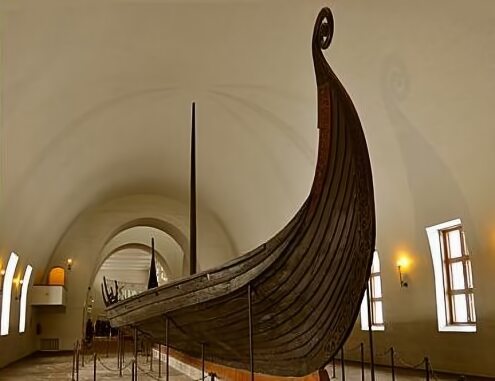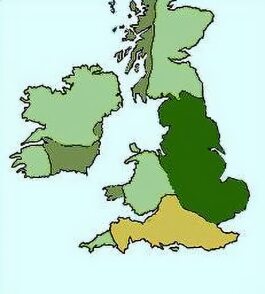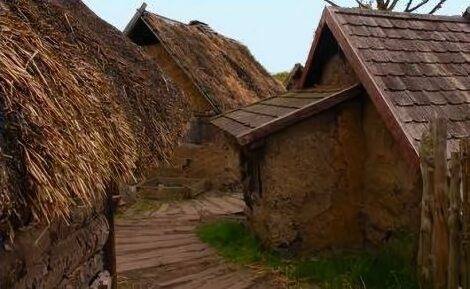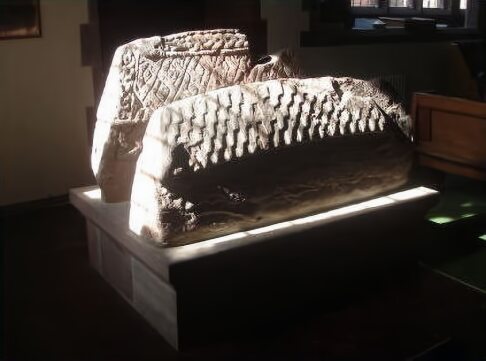From the fury of the northmen O Lord deliver us
The much-repeated Anglo-Saxon prayer " From the fury of the northmen O Lord deliver us" evokes the terror a Viking landing inspired in the Anglo-Saxon population. The Anglo-Saxon Chronicle ruefully records fearful omens in the year 793, lightning, high winds, flying dragons, famine, "and a little after that, in the same year, on 8 June, the ravages of the heathen men miserably destroyed God's church on Lindisfarne with plunder and slaughter."
The Great Heathen Army and the Formation of the Danelaw
The British coast had been subjected to waves of Viking raids which commenced in around 800. In 865 their intention appears to have switched from raiding to conquest when large Viking army, recorded as 'the Great Heathen Army' in the Anglo-Saxon Chronicle, landed in East Anglia under leadership of the ferocious Ivar the Boneless and his brother Halfdan, the sons of the legendary Viking leader Ragnar Lodbrok. They unfurled the Viking Raven banner in East Anglia, after acquiring horses from the East Anglians they proceeded north.
Viking longboat from the Viking Ship Museum, Oslo
The following year, Ivar took the city of York, known to the Vikings as Jorvik. Northumbria was at the time in a state of civil war, King Aelle of Northumbria had usurped the throne from Osberht who had ruled Northumbria for the previous eighteen years, however, they agreed to unite against their common enemy, it took 4 months for them to join their forces, and on 21st March 867, they stormed the city walls and gained entry to York in an attempt to relieve it. The Vikings rallied, slaughtered all those who had entered the city and routed those who were outside, both kings Aelle and Osberht were killed. In revenge for the killing of Ivar's father, Ragnar Lodbrok, who was thrown into a snake-pit on Aelle's orders, Aelle was subjected to the agonising death of the blood eagle, a gruesome Viking method of torture and execution which is sometimes mentioned in the Nordic sagas. It was performed by cutting the ribs of the victim by the spine, breaking the ribs so they resembled blood-stained wings, and pulling the lungs out through the wounds in the victim's back. Salt was sprinkled in the wounds. What was left of the Northumbrian court fled north, and Ivar installed Egbert as the puppet king of Northumbria.
The Great Heathen Army army progressed into Mercia fixing their winter-quarters at Nottingham. Burgred, the King of Mercia, sought aid from Ethered, King of Wessex and his brother Alfred, who led an army into Mercia and besieged Nottingham, however, the Vikings, heavily outnumbered, refused to fight. Burgred negotiated peace with Ivar, with the Danes' keeping Nottingham in exchange for leaving the rest of Mercia unmolested. In East Anglia, King Edmund led the resistance against them but was killed at Hoxne and they succeeded in conquering East Anglia.
The brothers Ethelred I and Alfred of Wessex again attempted to halt Ivar's advance by attacking the Vikings at Reading, but were defeated. On 7 January 871, Ethelred and Alfred won a victory at the Battle of Ashdown. The Vikings retreated to Basing, in Hampshire, where Ethelred attacked them but suffered defeat. The Vikings followed up this victory with another at Meretum (now Marton, in Wiltshire). Ethelred died on 23 April 871 and was succeeded as King of Wessex by Alfred. The Viking army turned north again and attacked Mercia, a campaign that lasted until 874, in which Burgred of Mercia was killed.
The Viking leader Guthrum completed the campaign against Mercia. In ten years they gained control over the Anglo-Saxon kingdoms of East Anglia, Northumbria and Mercia, Wessex alone continued the struggle to resist them. The depressing series of defeats at the hands of the Vikings continued unabated and Alfred was forced into a strategy of buying them off. As a result, they ceased their attacks and for five years, peace reigned in Wessex. This peace was not likely to last for any considerable length of time and was at best a temporary measure.
The Danelaw
The Viking army, after taking Mercia, divided. One part, under Halfdan, marched north to Yorkshire where they settled permanently. The other, under Guthrum, launched another attack on Wessex in 875. They withdrew again in 877 and began to colonise Mercia. Wessex was savagely attacked for the third time in 878 and Alfred was driven into hiding at Athelney in the Somerset marshes, he remained there, biding his time.
In 886, Alfred garnered his resources and managed to retake the city of London, but Viking raids continued. At the battle of Ethendun in 878, Saxon forces soundly defeated the Vikings lead by Guthrum and peace was concluded by the terms of the Treaty of Wedmore. Guthrum converted to Christianity and adopted the Saxon name of Athelstan, with Alfred standing as godfather to his erstwhile enemy. Alfred accepted the Danish colonisation of much of England, allowed them self-rule in the area. A line was drawn which ran north-westwards from London to Chester, defining an area north of this line which was termed the Danelaw. This was written as Up the Thames, and then up the Lea, and along the Lea to its source, then in a straight line to Bedford, then up the Ouse to the Watling Street.
Guthrum honoured the agreement with Alfred in the Treaty of Wedmore and the borders of Wessex remained unmolested. He withdrew his army from the borders of Alfred's territory and eventually settling in East Anglia in 879, he died there in 890 and is said to have been buried at the church of St. Mary in Hadleigh, Suffolk.
Archaeology
Repton Viking Burials
Professor Martin Biddle of Oxford University and his wife Birthe Kjølbye-Biddle claim that the skeleton of a six-foot tall Viking warrior, aged between 35 and 45, discovered during excavations at the churchyard of St Wystan's in Repton in southern Derbyshire may be that of Ivar the Boneless.
In 873 the Great Heathen Army is said to have travelled to Repton, where it took up quarters for the winter. The mass grave at Repton was initially uncovered in 1686 but the grave was eventually recovered and its existence forgotten. The Saga of Ragnar Lodbrok itself states that Ivar the Boneless was buried in England.
The body unearthed by Professor Biddle must have been that of a very important Viking warlord, as around this burial lay the bones of at least 249 bodies. As well as a sword, he had been buried with a small Thor's hammer and a boar's tusk. Examination of the bones revealed the warrior died a savage and brutal death. Two wounds on his skull were probably made by a spear and marks on the spine suggest the warrior was disembowelled after death. A violent blow to the top of the thigh could have removed his genitals, perhaps the reason why the boar's tusk was discovered between the legs of the skeleton, an attempt by those who buried him to make his body whole before his journey to Valhalla. Viking beliefs stipulated that a body could not enter Valhalla if it was not whole. According to Dr Bob Stoddart, of Manchester University, the man was stabbed in the head, jaw, arm and thigh and disembowelled. Each of his toes and both his heels were split lengthways. Birthe Kjølbye-Biddle claims the man would have been killed in a revenge attack following the destruction of the church and adjoining monastery.
Nearby, at Ingleby, further evidence of the Great Army was unearthed by archaeologist Julian Richards, of York University. A cluster of burial mounds was excavated in the 1950s, some of which appeared to have been the site of cremations. Goods found with the bodies also appeared to have been through the cremation fires. Sword and buckles, nails and wire embroidery all suggested these had been Viking cremations.
The Moels Viking Ship
In October 1991 a Wirral man, John McRae, visited the Viking exhibition at Liverpool Museum and later wrote to them about his father's discovery of a boat during construction of the new Railway Inn at Meols in 1938. During the work on the inn, a section of the boat had been revealed but he had been ordered by the site foreman to rebury it. He did however, make careful notes. The son's letter to the museum described where the boat lay, about 10 feet below the ground surface of the Railway Inn. A section five to six feet long of a 3 feet wide boat had been exposed.
Professor Stephen Harding of the University of Nottingham, an expert on the Merseyside Vikings, detected the outline of the vessel under the pub car park using state-of-the-art ground radar technology. He believes it is either a Viking transport boat, similar to a longship, or a ship from the centuries that immediately followed the Viking era. It has overlapping planks, typical of Viking "clinker" boats. Whilst Viking boat burial sites have been unearthed in Britain before, the wooden vessels have always been rotted away, leaving only their more durable contents. But the Wirral boat is preserved in waterlogged blue clay and thought to be almost completely intact. Professor Harding is now applying for European funding to carry out excavations of the site, believes the ship could be carefully removed and exhibited in a museum.
The Cuerdale Hoard
The Cuerdale Hoard, an enormous Viking silver treasure of some 8000 silver coins and pieces of bullion, was discovered in Lancashire, in 1840. It is one of several Viking hoards unearthed in the Danelaw, but is the largest to date. The hoard was found by workmen engaged in repairing the embankment on the south side of the River Ribble at Cuerdale, near Preston, where it had been buried in a lead chest around 905. Silver formed the basis of currency in the Viking Age and it was often buried in times of unrest. The Cuerdale Hoard is larger than any hoard found in Scandinavia. It is the largest Viking silver hoard ever found outside Russia.
Over the past 30 years, hundreds of new finds of Viking-Age metalwork have been unearthed in the area which once covered the Danelaw, mainly as a result of metal-detecting. Prominent among these are female personal ornaments (brooches and pendants), in both Scandinavian and Anglo-Scandinavian styles.
Place Names and Language
Dark age village
The influence of Viking settlement is still to be seen in the North of England and the East Midlands today. The area of the Danelaw is marked by the survival of Danish personal names and place names. Place name endings such as -by (meaning "village") such as Grimsby ('Grimr's town') and Wetherby ('sheep's town') or -thorp ("hamlet") indicate Norse origins, such as Scunthorpe. There are also place names that are a mixture of Anglo-Saxon and Viking words. These are known as 'Grimston hybrids', because -ton is an Anglo-Saxon word meaning town or village, and Grim is a Viking name.
Old Norse and Old English were still mutually comprehensible, sharing the same Germanic origin. The contact between these languages in the Danelaw caused the incorporation of many Norse words into the English language, including the word law itself, sky and window, and the third person plural pronouns she, they, them and their.
Most English words starting with sk are Norse in origin, such as skein, skirt and skill. They also introduced a number of words that reflected their lifestyle and origins, such as shoal, walrus sled, sledge, and the nautical term wake.
viking hogback stone
Many Old Norse words still survive in the dialects of Northern England. For instance, the Old Norse word 'gata' which means a way or a street or a road, is recalled in Micklegate, Kirkgate, East Gate, etc, in York. In parts of northern and eastern England, a 'gate' (which swings on hinges) is referred to as a 'bar' - again, this survives in York.
The majority of Cumbrian place names are of Norse origin, including Ulverston from Ulfrs tun ('Ulfr's farmstead'), Kendal from Kent dalr ('valley of the River Kent') and Elterwater from eltr vatn ('swan lake'). Many of the traditional dialect words are also remnants of Norse settlement, including beck (bekkr, 'stream'), laik (leik, 'to play'), lowp (hlaupa, 'to jump') and glisky (gliskr, 'shimmering').
Evidence of Norse settlement in Wirral can be seen from its place names, such as Helsby - hjalli-byr village at the ledge, Raby, from the Old Norse ra-byr meaning boundary or border settlement, Frankby (Franki's settlement), Greasby (wooded stronghold). Tranmere comes from trani melr ("cranebird sandbank"), Meols derives from the Old Norse for sandbanks or sandhills. West Kirby, or West Church Settlement, the settlement of Vestri Kirkjubaer in Iceland has the same name, which translates from Icelandic as West Kirby.
Genetic Evidence
The BBC commissioned a genetic survey of the British Isles in 2000 by a team from University College London led by Professor David Goldstein, developed for its series, 'Blood of the Vikings'. The survey concluded that the Vikings settled sporadically in Britain with a particular concentration in areas such as Orkney and Shetland. It proved impossible to genetically distinguish descendants of Danish Vikings from descendants of Anglo-Saxon settlers, on the basis that the latter two groups originated from areas that overlap each other on the North Sea coast. Therefore the Vikings in the survey refer to Norwegian Vikings only, which it was possible to distinguish. Research into population genetics has also found that a proportion of people formerly in the Danelaw have a genetic marker that is indicative of a British Celtic origin, indicating that there remained several Brythonic Celts within the Danelaw.
'Viking DNA: The Wirral and West Lancashire Project' the result of several years of research by biochemists and geneticists, by Wirral-raised Professor Steve Harding from The University of Nottingham and Professor Mark Jobling and Dr Turi King from the University of Leicester found that up to 50 per cent of the DNA from the men of both Old Wirral and Old West Lancashire ancestry was Viking in origin.
From generation to generation, the DNA of the male Y-chromosome is passed along the paternal ancestry, the team of researchers took advantage of the fact that surnames are also passed along the same lines. The method proved to be especially powerful being applied not to individuals but whole populations. Thus the group of volunteers had to be selected according to certain areas and specific surnames present in these areas at least before 1600. DNA tests on around 100 men from the area who had local surnames dating back hundreds of years. Some names were sourced from a tax register from the time of King Henry VIII, others from lists of alehouse and criminal records, and a list of people who contributed to the stipend of a priest. Scientists found two men from Meols who shared identical historical links to Scandinavia during DNA studies, their strongest DNA link was to Gotland, an island off the east coast of Sweden.
Studies of the blood groups of Scandinavia, northern Germany and eastern England reveal a marked similarity, with the exception of towns, where significant population movement has taken place, each of these areas contain around 70% blood group A. In rural Wales, an area controlled by the Celts the most common blood group is Group O.
Eric Bloodaxe PreviousNext Battle of Edington
